Delphi: Challenging the USDT model, revenue-sharing stablecoins are ready for development

Reprinted from panewslab
12/21/2024·5MBy Robbie Petersen, Researcher, Delphi Digital
Compiled by: Luffy, Foresight News
The total supply of stablecoins continues to rise steadily, and this total masks a more concerning detail. While cryptocurrency trading volumes remain below all-time highs, the number of active addresses transacting with stablecoins each month continues to climb. This disparity suggests that stablecoins are not simply acting as gear grease for cryptocurrency speculative casinos, but are finally delivering on their core promise: becoming the foundation of a new digital financial system.
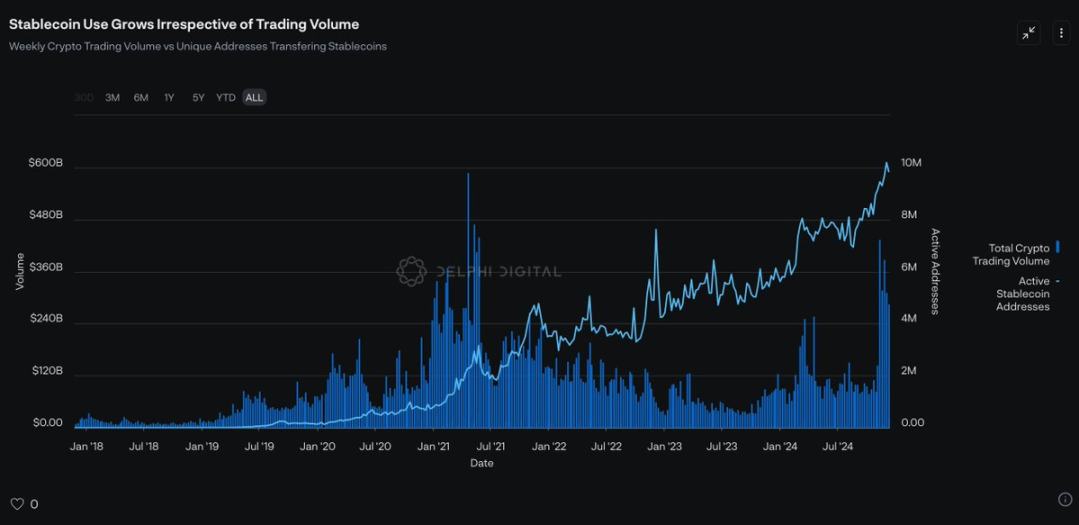
Source: Artemis, The Tie
Perhaps more importantly, there are some clear signs that mass adoption will not necessarily come from emerging startups, but from those that already have established distribution channels. In the past three months alone, four major fintech companies have officially stated that they will enter the stablecoin space: Robinhood and Revolut are launching their own stablecoins; Stripe recently acquired Bridge to promote faster and cheaper global payments. ;Visa is helping banks launch stablecoins, albeit to the detriment of their own interests.
This marks a new paradigm shift: stablecoin adoption no longer depends on purely ideological assumptions. Instead, by offering fintech companies a simple proposition of lower costs, higher margins, and new revenue streams, stablecoins find themselves intrinsically in common with the most reliable force in capitalism: the obsession with profit. Relentless pursuit. Therefore, as market-leading fintech companies leverage stablecoins to increase margins and/or expand more payment stacks, we will inevitably see the rest of their competitors follow suit and join the stablecoin battleground. As I emphasized in my “Stablecoin Manifesto,” game theory shows that the adoption of stablecoins is not an option, but a necessary bet for fintech companies to maintain their market position.
Stablecoin 2.0: Revenue Sharing Stablecoin
Intuitively, the most obvious beneficiaries of these structural favorable factors are the issuers of stablecoins. The reason is simple: Stablecoins are essentially a winner-takes-all game given currency network effects. Today, these network effects are mainly reflected in three aspects:
- Liquidity: USDT and USDC are the most liquid stablecoins in the cryptocurrency market. Using some emerging stablecoins means traders have to bear more slippage;
- Payment: USDT has become an increasingly common payment method in emerging economies, and its network effect as a digital medium of exchange is arguably the strongest;
- "Denomination Effect": Almost all major trading pairs on CEX and DEX are denominated in USDT or USDC
Simply put, the more people use USDT (Tether), the more convenient it will be to use USDT, and more people will use USDT. The result of this is that Tether increases its market share and enhances profitability.
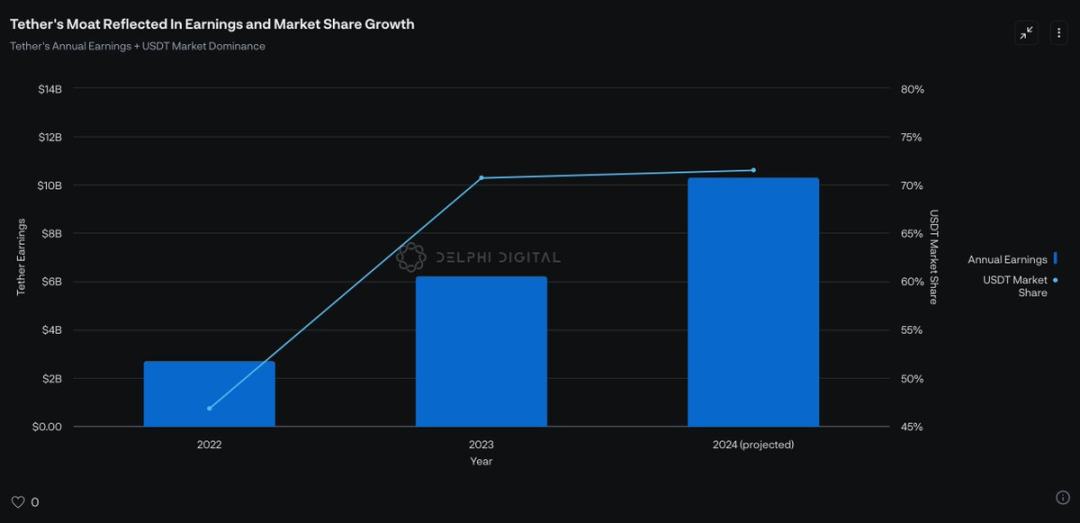
While Tether’s network effects are nearly impossible to fundamentally break, there is an emerging stablecoin model that seems best suited to challenge Tether’s existing model: revenue-sharing stablecoins. Importantly, this model is well positioned within the stablecoin paradigm increasingly adopted by fintech companies. To understand why, there are some prerequisites you need to know.
Today, the stablecoin ecosystem stack typically consists of two main players: (1) stablecoin issuers (such as Tether and Circle) and (2) stablecoin distributors (i.e. applications).
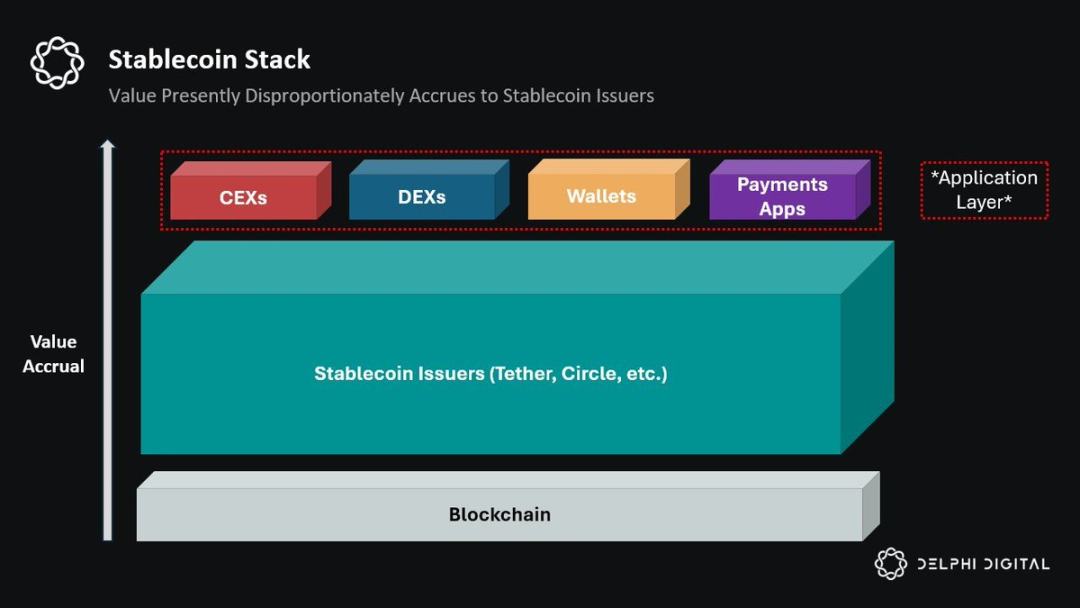
Currently, stablecoin issuers create more than $10 billion in value annually, exceeding the revenue of all blockchains combined. However, this represents a huge structural inefficiency: the value generated in the stablecoin stack is fundamentally distributed downstream. In other words, without exchanges, DeFi applications, payment applications, and wallets integrating USDT, USDT would have no utility and therefore would not generate any value. However, despite this, "distributors" currently do not obtain corresponding economic benefits.
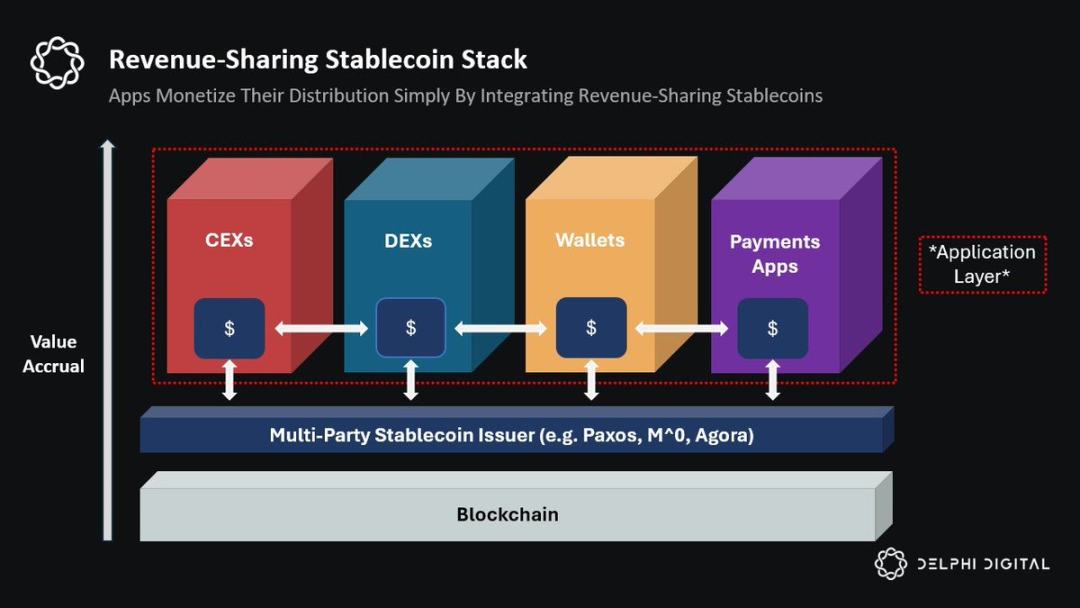
This has led to the rise of a new group of stablecoins: revenue-sharing stablecoins. This model disrupts the existing system (the USDT model) by reallocating the economic benefits traditionally captured primarily by stablecoin issuers to applications that bring users to the collective network. In other words, revenue-sharing stablecoins enable applications to effectively take a share of the revenue from their own distribution channels.
At scale, this could be a meaningful revenue stream, perhaps even the primary revenue stream for larger applications. Therefore, as margins continue to compress, we may be entering a world where the primary business model for crypto applications evolves into effectively selling stablecoin issuance as a service (SDaaS). Intuitively, this makes sense, as stablecoin issuers today capture more value than the blockchain and applications combined, and applications may get a much larger share of the value than from other sources.
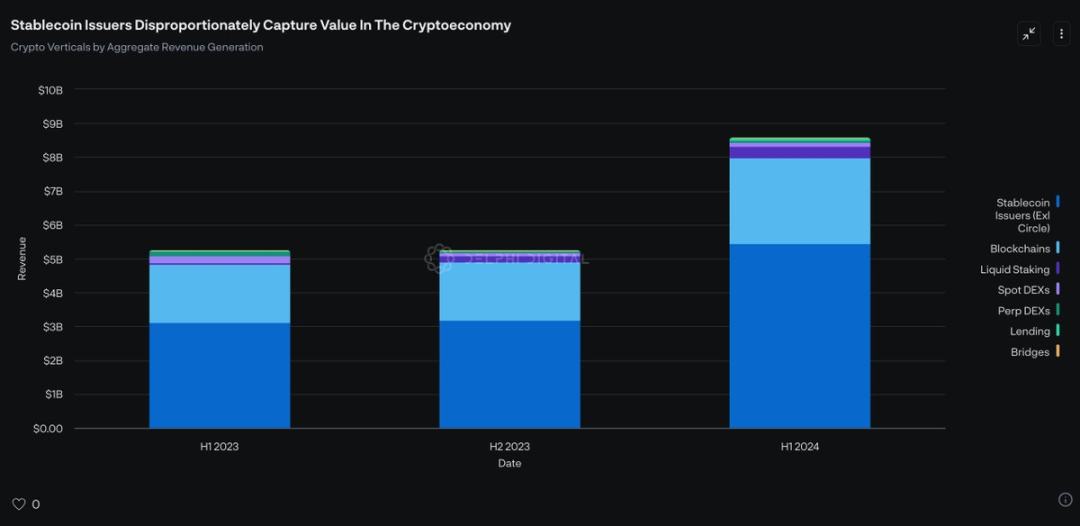
Although there have been countless attempts to break Tether’s monopoly so far, I believe that the revenue-sharing stablecoin model is the right direction for two reasons:
- Distribution is everything: While previous attempts to issue revenue-generating stablecoins first sought support from end-users, revenue-sharing stablecoins target the players who own users: distributors. This shows that the revenue sharing model is the first model to inherently combine the incentives of distributors and publishers at the same time.
- There’s power in numbers: Historically, the only way for an application to reap the economic benefits of stablecoins was to launch its own independent stablecoin. However, this approach comes at a cost. Given that other applications have no incentive to integrate your stablecoin, its utility is reduced to being limited to their respective applications. Therefore, it is unlikely to compete with USDT’s network effects in scale. Instead, by creating a stablecoin that incentivizes numerous distribution-capable applications to integrate simultaneously, revenue-sharing stablecoins are able to leverage the collective network effects of the entire “distributor” ecosystem.
In short, a revenue sharing stablecoin has all the advantages of USDT (composability and network effects across applications) with the added advantage of incentivizing those participants with distribution channels to integrate and share revenue with the application layer .
Currently, there are three leaders in the revenue-sharing stablecoin space:
- Paxos’s USDG: Paxos announced the launch of USDG in November this year and is regulated by the Monetary Authority of Singapore’s upcoming stablecoin framework. It has currently secured a number of heavyweight partners including Robinhood, Kraken, Anchorage, Bullish and Galaxy Digital. .
- The “M” of M^0: With a team composed of ex-MakerDAO and ex-Circle veterans, M^0’s vision is to serve as a simple, trusted and neutral settlement layer that allows any financial institution to mint and redeem M^0 Revenue sharing stable currency "M". However, one of the differences between "M" and other revenue-sharing stablecoins is that "M" can also be used as the "raw material" for other stablecoins, such as USDN (Noble's revenue-sharing stablecoin). In addition, M^0 uses a unique custody solution consisting of a decentralized network of independent validators and a dual-token manager system, providing higher trust neutrality and transparency compared to other models. You can read more about M^0 in my post.
- Agora's AUSD: Similar to USDG and "M", Agora's AUSD also shares revenue with applications and market makers that integrate AUSD. Agora also has strategic support from numerous market makers and applications, including Wintermute, Galaxy, Consensys and Kraken Ventures. This is noteworthy because it aligns incentives with these stakeholders from the outset. Today, the total supply of AUSD is $50 million.
In 2025, I expect these stablecoin issuers to gain increasing attention as distributors collaborate and guide users to stablecoins that benefit them. Additionally, we should also see market makers (who play an important role in ensuring that stablecoins remain sufficiently liquid) showing a preference for these stablecoins, as they also gain some economics from holding inventory of such stablecoins benefit.
While “M” and AUSD currently rank 33rd and 36th respectively by stablecoin supply, and USDG is not yet online, I expect at least one of these stablecoins to be in the top 10 by the end of 2025. Additionally, by the end of the year, I expect the overall market share of revenue-sharing stablecoins to rise from 0.06% to over 5% (~83x) as large fintech companies with distribution capabilities will bring the next wave of stablecoin adoption.
Stablecoins are poised to take off
While the Eurodollar adoption curve is often used as a historical analogy for stablecoins, the analogy is somewhat simplistic. Stablecoins are not Eurodollars, they are digital in nature, they are available globally, they enable instant cross-border settlement, they can be used by AI agents, they are subject to massive network effects; and most importantly Yes, existing fintech companies and businesses have clear incentives to adopt them because stablecoins fit every business’s goal: to make more money.
Therefore, saying that stablecoin adoption will follow the trajectory of Eurodollar adoption ignores a fundamental issue. The only thing I think stablecoins have in common with Eurodollars is that they will continue to emerge as a bottom-up phenomenon that cannot be controlled by any institution or government that thinks the technology is contrary to their interests. However, unlike Eurodollars, stablecoin adoption will not happen slowly over 30-60 years. It starts slowly and then explodes as network effects quickly reach escape velocity.
The regulatory framework is being established. Fintech companies like Robinhood and Revolut are launching their own stablecoins, and Stripe appears to be exploring stablecoins for more payments stacks. On top of that, existing businesses like PayPal and Visa are still exploring stablecoins despite eating into their own profits because they fear that if they don’t, their competitors will.
While it is unclear whether 2025 will mark an inflection point in the history of stablecoins, it is clear that we are approaching it.



 chaincatcher
chaincatcher
 jinse
jinse